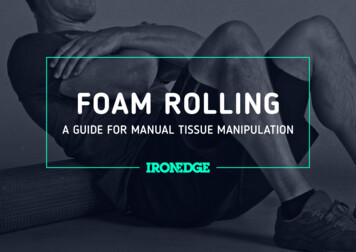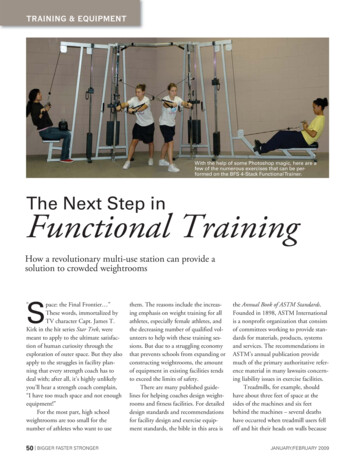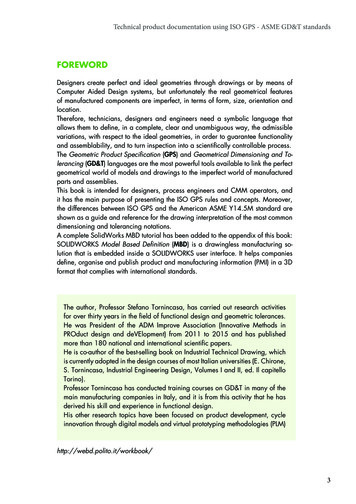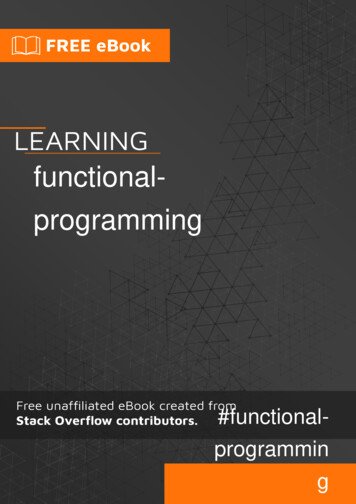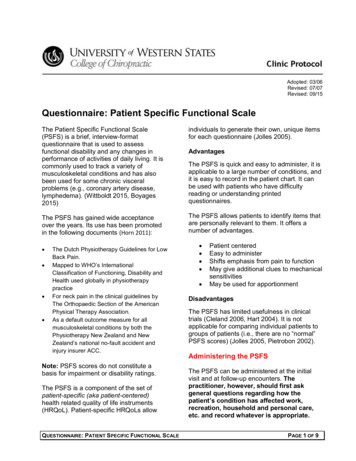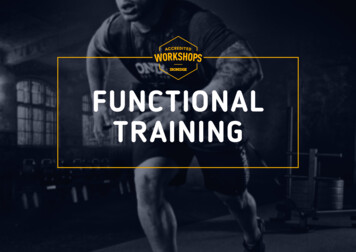
Transcription
FUNCTIONALTRAINING
This manual is your guide for taking your training to the next level, incorporating functional training methods for you and your client to improveperformance and maximise results.This manual will supplement your skill-based knowledge and build furtherupon the functional training methods outlined in the Iron Edge FunctionalTraining workshop. The manual delves deep into functional training conceptsand provides a reference useful to coaches and personal trainers in their pursuit of improved physical performance, whether it is for sports or daily living.AIMS OF THE FUNCTIONAL TRAININGWORKSHOP AND MANUAL: To introduce and define the concept offunctional training, including the benefitsand the target population Outline the functional anatomy systems andplanes of motion associated with functionaltraining Provide basic screening protocol objectives andparticular methods of how to screen clients andathletes for functional training Introduce single-leg training and the differencebetween supported and unsupported exercises Demonstrate how functional training relatesto human movement, the role of specificfunctional training prescription and the bestmethods of implementing functional trainingto improve movement Outlining how to incorporate functional trainingmethods into the existing training program,and how retention of human movement canoccur through trained chunking and trainingtechniques How to incorporate functional training intothe training programSAFETY PRECAUTIONSSafety should always be the first priority whenteaching lifting techniques. To enhance safetyand reduce risk of injury, ensure the followingpoints are met:1. Always ensure you have sufficient room forperforming various lifts, away from any hazardsor obstacles.2. Always ensure close supervision of all lifts,especially for beginners. When techniquebreaks down in any exercise, stop the exerciseto reduce injury risk.3. Always begin with a bodyweight (or use adowel) to teach movement patterns andscreen clients for appropriate range of motion,and ensure technique is sound before addingexternal load.4. If pain occurs at any time - STOP the exerciseand seek treatment.5. Ensure breathing technique is learnt andexecuted before heavy lifting.02 / WORKSHOP MANUAL, FUNCTIONAL TRAINING
WHAT YOU WILL GAINFROM THIS COURSEAs a trainer in the fitness industry, you have many other trainers competing for clients,jobs and positions. You also have a responsibility to those that you train that you providethe best possible service, and clients and athletes you work with expect you to help themnot only achieve their individual goals but to do so in a safe manner.This Iron Edge Functional Training workshop will provide you with extensive knowledge offunctional training concepts, raising you above the competition in terms of training methods and the research background behind them. Having knowledge of functional trainingis one thing, but being able to fully understand it, explain it and then be able to safely prescribe and modify training based on its’ methods will boost your reputation and skill set for along and successful career in the industry.This workshop and manual will provide you with this knowledge and teach you particularskills and techniques required to understand functional training as best as possible, andprovide a foundation for performance training.
CONTENTSIntroduction to Functional Training›› What is Functional Training? 05Open and Closed ChainMovements 19›› Origin of Functional Training 05Instability vs. Stability 20›› Theory behind Functional Training 05›› What is not Functional Training? 06›› Benefits of Functional Training 07›› The Relevance ofFunctional Training 07Functional Training Exercises 21›› Back to Basics 22›› Lower Body Dominant Patterns(Squat, Hinge, Lunge, Gait) 23Functional Anatomy›› Upper Body Dominant Patterns(Pushing, Pulling, Midline/Core) 27›› Planes of Motion 08›› Collective or Total Body Patterns›› The Sling System 09(Gait, Midline/Core, Power Line andSnatch, Throws, Slams, Turkish Get Up,Power Rope Waves) 30Bracing and the Neutral Spine 10Programming Functional Training 36Introducing Functional Traininginto the Program 11Functional Training Equipment 38›› Inner Core vs. Outer Core 09›› 1. Needs Analysis 12›› 2. Screening for Functional Training 12›› 3. Movement Selection 15Conclusion 45References 46
INTRO TOFUNCTIONAL TRAININGWHAT IS FUNCTIONAL TRAINING?Functional Training involves training skills and motor patternsthat relate closely to common human movement, with the aimto improve the ability to complete such movements. Basically, itinvolves training the body in the way that it was designed to move.It’s underpinning philosophy is derived from performing everydaymovements, that have been a staple of human behavior for hundredsof years. Squatting, lifting, pushing, pulling and rotational movements performed with feet on the ground comprise the majority offunctional training movements.ORIGINS OF FUNCTIONAL TRAININGIt’s popularity has grown immensely in recent years and stemsprimarily from athletic conditioning in the sporting world, where athletes train their bodies specifically to their sport in order to improveperformance. However its application is still in the infancy stages insome quarters, with people wrongly applying the term ‘FunctionalTraining’ to their training programs5. Fundamentally, functionaltraining should stress the body in methods and movements thatare realistic, practical and purposeful to the individual. Thereforethe concept of functional training revolves around the training ofMOVEMENTS, not MUSCLES, and could equally be referred to as‘performance training’.THEORY BEHIND FUNCTIONAL TRAININGLinking the human body to move in a synergistic fashion engagesmore muscles, is more demanding on the neuromuscular systemand allows for muscle co-ordination, as opposed to splitting the bodyinto separate units and training them individually6. Integrating movement in this whole-body manner is another foundation of functionaltraining, shifting away from the bodybuilding ideals of training muscles in isolation. The focus of functional training not only involvestraining the body to move more effectively and in a sequencedmanner, whether in daily activities or in a sporting sense, but also toreduce injury risk through creating a unified neuromuscular system05 / WORKSHOP MANUAL, FUNCTIONAL TRAININGwhere segments work in smooth association with one another.A functional training program is often not focused on getting biggerbiceps or a 6-pack, but improving the ability of the body to moveeffectively and in harmony to improve performance. The focus is onbuilding strength in particular areas throughout movements that willassist the individual once they leave the gym.Functional Training is organised and systematic in its trainingmethods, designed to better prepare an individual or athlete for thephysiological demands of their situation. Aspects and principles offunctional training should be present and practiced throughout alltraining programs, and will be explained throughout the manual. Ifyou are not incorporating functional training methods in your currenttraining programs, you may be creating a detrimental scenario foryourself and your clients in terms of injury and functionality.This manual will outline training particular movements involvingaction over a number of joints in a number of different planes ofmotion, aiming to develop fluidity in motion instead of developinggreat skill in one particular exercise. For example, having a strong,functional lower body means a client should be able to demonstratestrength over many lower-body movements. The inverse of thismay be a client who has trained for years on the leg press machineand has the ability to press heavy loads, but once they are asked toperform a squat they are not only not able to replicate similar loads,but have an unstable core and cannot achieve sufficient depth.Therefore whilst they are highly skilled in the leg press and able toperform well, their strength is not functional as it does not translateto other movement.The overriding notion of functional training is the inter-relationship ofmuscles and joints, and how they are not limited to one function ormovement. Muscles can act as a stabiliser, a prime mover, a synergistmuscle or an antagonist, whilst acting around a joint in differentsituations. Functional training aims to train in this manner, improvingthe ability of the neuromuscular system to perform a wide range ofmovements and skills that will ultimately assist in the performanceof tasks6, 7.
INTRO TO FUNCTIONAL TRAININGWHAT IS NOT FUNCTIONAL TRAINING?Importantly, the functionality of training is dependent on the client and the context5. Thereforewhat may be functional for one person may notrelate to the goals or needs of another person.In general population terms though, functionaltraining does NOT involve isolating muscles andtraining movements to small range of motionsor single plane activities. Generally, humanmovement tends to not be limited to single-jointmovements that isolate a particular muscle group.This scenario may be more appropriate for injuryrehabilitation, which will be discussed.To demonstrate the common, traditionalapproach to training, consider the followingscenario:An untrained man walks into a gym for the firsttime. He plays football for his local club and islooking to improve his on-field performance, andhis coach has suggested he should get strongerif he wants to make the senior team. Havingnever weight-trained before, he opts to followthe lead of other gym-goers who are working out.Throughout the session he completes machinechest flies, bicep curls, triceps pushdowns andlat pull-downs. He finishes with some crunches,then leaves.Most of the exercises were performed either onthe floor or seated. None related to movements orjoint angles common in football, and training thisway will likely give rise to dysfunction.Whilst following this program strictly will likely leadto muscle gains for a beginner, long-term adaptations will possibly promote injury, joint immobilityand movement issues and a lack of strength in keyareas. A noticeable absentee in the session wasany focus on lower body or full body movements.As will be discussed throughout the manual, thesource of human movement stems from ourtrunk and the power-generating capacity of thelarge muscle groups of our lower body, thereforeinclusion of movements integrating these areas arecritical when discussing functional training.The above type of training is not considered ‘functional’, as it trains the body as separate identitiesand will likely isolate muscle and joint movement.Whilst that may be considered appropriate forbodybuilders and injured populations, the majorityof people who spend time and money on trainingwould be better off applying a functional attitude towards their training to maximise trainingefficiency. What good is it for an individual to havea great-looking, massive chest but lack the abilityto safely lift a heavy couch when moving house, orreach down to pick their child up off the ground?Unfortunately, this is an all too common scenarioseen in many commercial gyms. There is no programming or structure, and the exercises involveisolating individual muscle groups.06 / WORKSHOP MANUAL, FUNCTIONAL TRAININGWhilst you are contemplating that,try and answer the following questions:1. How often in daily movement does an individual sit on chair with bent legs and extend theirknees against a heavy resistance, as they do ina seated leg extension?2. Is there a sport that requires someone standwith a load in their hands and only move theirlower arm to flex the elbow and bring the loadtowards their head, as the bicep curl involves?3. Have you ever had to squat down on an unstable surface with one leg throughout the day,whilst holding load in your hands, as you mightdo in a loaded pistol squat on a Bosu ball?Predictably, these movements are not commonin daily life and therefore have little transfer topractical human movement patterns. Whilstisolating a muscle (or group of muscles) orjoint, or training on an unstable surface, may beimportant in rehabilitation settings to improvestrength following an injury it has little worth orcontribution to linking the human body parts tosuccessfully and efficiently perform a serviceablemovement. Functional training moves away fromthese single-joint, muscle isolation exercises andaims to encompass universal movement in itstraining methods.There is no debate that single-joint, isolationexercises will likely lead to increased strengthand muscle hypertrophy, however that type ofresistance training does not take into accountsynergistic muscles.Complex, high-intensity, multi-joint movementsstimulate a large anabolic hormonal response,and the heavier loads able to be lifted in functional movements will likely lead to hypertrophyacross the entire muscular system due to thehormonal spike8, 9. Therefore functional trainingcould be viewed as much more efficient in itstraining methods, promoting stimulation acrossmore muscles in less time10. The great benefit infunctional training is that it leads to a balanced,symmetrical and coordinated muscular system,through connecting body segments and activationof the trunk to better relate to daily or sportingactivities 10, 11.Isolating muscle and joint movement also failsto train the sling systems in the body, this willbe explained throughout the manual. Trainingin an isolated fashion neglects the effect that aconcentric contraction of one muscle has on thefascia of another, whereas functional training aimsto view the body as a whole and take into accountsequenced movement ‘down the chain’ to eventually produce more efficient, practical movement.Anabolic hormones are also elevated to a lesserdegree in isolation exercises, therefore adaptationsin muscle strength or body composition may becompromised10.
INTRO TO FUNCTIONAL TRAININGBENEFITS OF FUNCTIONAL TRAININGTHE RELEVANCE OF FUNCTIONAL TRAININGThe benefits of Functional Training are infinite, and willcontinue through the individual’s lifetime and extendinto activities well away from training in their daily tasksand jobs:Assimilating functional training strategies into a training program willbenefit everyone, from the mother-of-three looking to start physicalexercise to the weekend warrior athlete to the elite Olympic competitor preparing for an international event. The actual prescription offunctional training will differ between the three individuals in terms ofexercises, load and intensity, however all three will gain benefits frombasing their training around a functional standpoint. Everyone standsto benefit from functional training, as it can be guided by individualneeds and demands of the client. Improved postural and spinal stability under variousconditions Improved range of motion, dynamic stability and jointmobility Improved linkage of the kinetic chain (sequencedmovement throughout the body) through enhancedrelationship between musculoskeletal andnervous system Improved confidence in the ability to perform daily tasks Reduced injury risk and increased injury preventionmeasures Ability to train a variety of training y) Every session targets the entire body greater efficiency Greater hormonal response due to large muscle groupsbeing trained Periodise training to progress and challenge the humanbody in realistic means A more balanced, co-ordinated relationship between themuscular and nervous systems A FUN, DIFFERENT, EFFECTIVE way to train with variousequipment07 / WORKSHOP MANUAL, FUNCTIONAL TRAININGHOW RELEVENT ARE THESE EXERCISESBased on performance and adaptation, implementing a functionaltraining mentality allows coaches and athletes to challenge andprogress their athletes or clients at a steady rate. Training movementpatterns associated with activities of daily living will make trainingrelevant to the individual and also increase ‘buy-in’, as they learnand observe how their increased strength developed through trainingtransfers to a better ability to perform, be it on the sporting field orin everyday life.Due to the movement patterns associated with functional training, screening is required before a functional training program isprescribed, regardless of the individual. The screening processshould assess an individual’s mobility and ability to safely achievevarious body positions. This will allow the trainer to gauge anunderstanding of the movement characteristics of their client, andmay exclude the client from particular exercises for safety reasons.The screening process can also teach the basics of technique andmovement tempo, and is a critical step in the training process.It is critical when prescribing programs that the goal of each exercisealigns with helping to achieve the client’s goals. Basically, everythingthat is in the training program should have a viable reason for beingincluded. If not, you are not only wasting your time but that of yourclients. This will be explained in more detail throughout the manual.TO THESE ACTIVITIESWHAT CAN FUNCTIONAL TRAINING BE USED FOR?Once understood, functional training ideals can be used for a widerange of purposes. Personal Training Sessions Group Training Sessions Sports Training Rehabilitation
FUNCTIONAL ANATOMYThe anatomy of the human body is often lookedat in stationary form, about how the musclesinteract around a single joint in the anatomicalposition. From a functional training standpoint, themuscles, skeletal system and joints work as oneunit to create movement and perform specificskills. Movement does not occur in the anatomicalposition and rarely, if ever, are humans subjectedto single joint actions in order to achieve a task.Therefore our physical system must be capableof integrating movement over several joints andinvolve multiple muscle groups in a safe manner inorder to perform everyday movements.A much more functional method of viewinganatomy is considering the muscles as theproducers of movement. The neuromuscularsystem does not work in isolating muscles formovement, but instead initiates movements inwhich the muscles play a role. It is important thatthe muscles are synergistic and symmetrical, asthis promotes equal, balanced motion. Musclesthat are responsible for pulling movements shouldbe equal or close to equal in strength capacity tothose involved in pushing movement, to createsuch a balanced muscular system able to produceforce in symmetrical fashion. If there are strengthdeficiencies in a particular area, there may be anincreased injury risk or a performance decrementassociated with that area of weakness.PLANES OF MOTIONAll movement can be described as occurring inone or more of three planes:1. Frontal PlaneSplits the body into anterior and posterior divisionsMovements: Abduction, adduction, inversion,eversion, lateral flexion.Examples of frontal plane exercises: side lunges,lateral raise, shoulder press2. Sagittal PlaneSplits the body into left and right divisionsMovements: Flexion/ExtensionExamples of sagittal plane exercises: Barbell Squatsand Deadlifts, front raises, forwards lunge.3. Transverse PlaneSplits the body into superior and inferior divisionsMovements: Rotation, Horizontal flexion/extensionExamples of Transverse plane exercises:Woodchops, Rotational Throws.Traditional training methods will constrict movement to only occurring in a single plane, whereasfunctional training involves movement over morethan one plane.08 / WORKSHOP MANUAL, FUNCTIONAL TRAININGThis is where functional training excels in its abilityto transfer strength and movement, as functionalexercises aim to emulate multi-planar movementsin sports and daily life. Functional training is3-Dimensional, with no preference towards aparticular plane of movement.For example, the movement pattern of a cleaninvolves all three planes of motion. Therefore theclean closely relates to many movements in sportsthat require explosive power off the playing surfaceand the ability to control the trunk and coordinatea movement with the upper limbs as well (e.g. volleyball spike, leaping for a mark in AFL). Whilst notexactly replicating the sporting movements, theclean trains the co-ordination of the muscles andbody position therefore is much more functionalthan a seated shoulder press for athletes.Even when we walk, we are undergoingmovement in the frontal plane (hip abduction/adduction) as well as the sagittal plane (leg flexion/extension). If we drop something and walk topick it up, as we bend at the hip we horizontallyflex and therefore involve the transverse planein our movement. Functional training’s relationship to daily movements is endless, therefore itmakes sense to train the body in such a mannerthat engages and stimulates movement in allthree planes.
FUNCTIONAL ANATOMYINNER CORE VS. OUTER CORETHE SLING SYSTEMSThe trunk of the body provides the starting pointfor all human movement. Kicking a football cannotbe done without activation of the core musculature, neither can shovelling gravel or paintinga wall. Likewise, reaching into the car to undo achild from their car-seat and lifting them out ofthe car requires a large amount of core activation.Weakness in the core often translates to decreasedforce production and less efficient movements.The movement produced by the outer core unitstems from one of four major muscle systemsthat control human locomotion. These systemsare known as ‘Sling Systems’ and involvecoordination of muscles within the humanbody. Comprehension of the sling systems andtheir relation to each other provides a greaterunderstanding of human movement - in particular functional movement and how the variousmovements integrate together.To describe the core system, it is divided into twodifferent identities. The ‘inner’ core unit is viewedas everything between the pelvic floor and thediaphragm, bordered by the transverse abdominis(anterior) and the lumbar multifidus (posterior). Theroles of the inner core unit are to stabilise varioussegments of the spinal column for movementand to provide appropriate, involuntary muscleactivation for respiration. Therefore the inner coreis quite reactive, in that it engages without thought.The inner core also provides a strong, coordinatedbase for human movement. The ‘outer’ core consists of the ‘working’ muscles, namely the gluteals,erector spinae, rectus abdominis, latissimus dorsi,adductors and external obliques. They are largelyforce producing muscles, which provide posturalstability and resist external loads.For productive, functional movement, bothcore units must work in tandem. The inner coreprovides spinal stability and a base for movementto work off, whilst the outer core is responsible forproducing force and working against a resistance.The outer core unit is unable to create large forceswithout the solid base provided by the inner coreunit, whilst the inner core unit is unable to producesufficient force and movement to functionallycreate motion.Evidently, often the sling systems will overlapwhen a functional movement occurs overmultiple planes. For example, pelvic stabilisationis supported by the function of the deep longitudinal system, the anterior oblique system andposterior oblique system when on two legs12,whilst the lateral system acts to maintain hipposition in one-legged movements. In sport, thesling systems closely interrelate in throwing andkicking actions, as well as rotational movementssuch as swinging implements or wrestling.In daily work, the sling systems can be integrated through common bending and twistingmovements. This lends further weight to thebenefits of functional training, as it can preparethe body to work as one unit for plannedmovements, but also prepare the body forefficient motion for unpredictable actions.Integrating movement in a way that incorporatesvarious sling systems trains the whole body tolink segments and ultimately provide efficient,balanced movement.09 / WORKSHOP MANUAL, FUNCTIONAL TRAINING1. THE DEEPLONGITUDINALSSYSTEMThis system outlinesthe transfer of energyfrom the foot duringheel strike, through theperoneus longus andbiceps femoris of theposterior leg, crossingover to the oppositehip and up through theerector spinae via thesacrotuberous ligament.An arabesque is agreat way to train thedeep longitudinal slingsystem, as it requiresstability throughout thesacro-iliac joint.Exercise examples: Split stance contralateral press,Bulgarian bag side to side swing, golf swing.2. THE ANTERIOROBLIQUE SYSTEMThe AO system worksby creating an anchorpoint around whichthe body can rotateto allow for anteriorrotation. The adductorsof the front leg createthis base which allowsthe outer core obliquemuscles to control thetrunk during rotation.For example, a stablefront leg in a throwingmotion allows for thetrunk to forcefullyrotate to transferenergy up the kineticchain and into thethrowing implement.Exercise examples: Split stance contralateral press,Bulgarian bag side to side swing, golf swing.3. THE POSTERIOROBLIQUE SYSTEM4. THE LATERALSYSTEMThe PO system is similarto the AO system, but forthe posterior muscles inthe body. The hamstrings,gluteals and erectorspinae in particular willwork together to producehip and trunk extension(think hinge movementslike deadlifts) while othercore muscles such as theobliques and rectusabdominus work tostabilise the torso. Thisensures that forceproduced is effectivelyused to propel the bodywhen running for exampleThe lateral systemkeeps the torso uprightand the body verticalin general. A laterallyleaning position isgenerally weak and notideal for eitherproducing or absorbingforce. Muscles such asthe gluteals, obliquesand rectus abdominuswork together tomaintain stability,perhaps best visualisedby an athleteabsorbing a bump froman opponent andmaintaining theirfooting.Exercise examples: Off-set lunge, Single leg RDL,Split stance cable row.Exercise examples: Landmine full body twist,Pallof press, Single arm farmers walk
BRACINGANDNEUTRALSPINEWORKSHOP MANUAL10 / FUNCTIONAL TRAININGBracing basically allows the body to lift in the safest possible manner and can be easily achieved andtrained. Bracing (known as a high-tension technique) involves co-contraction of transverse abdominis,erector spinae, internal and external obliques, and rectus abdominis, the muscles that surround thespine13. Together, these muscles act as the human bodies in-built weight belt, wrapping around thespine to protect and stabilise whilst under load or throughout movementBREATHINGHOLLOW BODYIncreasing the capacity of the thoracic cavity (lungvolume) will contract the diaphragm and ‘switchon’ these core muscles11. This process will co-ordinate trunk musculature throughout the anteriorand posterior regions to isometrically contract andprovide strong foundation support for all lifts14.Taking a large breath in before a lift or movementwill raise the intra-abdominal pressure and stabilisethe spine. This functions to protect it from thecompressive forces that are commonly placedupon the spine throughout lifting, and maintainingthe held breath throughout the lift or movementsustains the brace. Exhaling fully before a lift iscomplete diminishes the pressure and acts as an‘off’ switch for spinal stabilisers, increasing the riskof an injury due to insufficient support. This is aprocess that should be trained, as clients come tounderstand that maintaining a held breath throughout a movement will aid in their stabilisation.Another technique to improve trunk stability istraining the hollow-body position. Often used ingymnastics settings, the hollow body positionhelps to integrate the upper and lower bodysegments and remain stable throughout particularmovements, as well as maintaining a neutral,straight spine. The hollow body position is oftentaught from the floor. There is no lumbar flexionin the hollow body position, and the position endswhen the back ‘breaks’ off the floor. Improvementin the hollow-body position can be gauged bythe position at which an individual ‘breaks’ andloses stability in their midsection as their legs tracktowards the ground. The lower the legs to theground in a controlled trunk position, the greatertrunk stability. Improved trunk stability will transferto the movements discussed in the manual, andimproving bracing techniques as the spine isprotected. Another advantage is a strong, stablebase for initiating limb movement.GLUTE SUPPORTTRANSFERABILITYThe bracing procedure can be aided by includingthe lower body in the process. By creating tensionthrough the glutes at the same time as the trunk,the kinetic chain is further supported. The glutesmake up one of the most powerful muscle groupsin the human body, capable of producing highlevels of force and power as well as stabilisingthe hip complex11. Activation of the glutes will inturn more likely activate the adductors, abductorsand surrounding hip flexors to support the lift andbrace also. In relation to the sling systems, thelower body is very important in bracing the bodyand providing a stable base from the foot, throughthe torso and into the upper limbs.Once proper bracing and high-tension techniquesare learnt, they will be easily transferable to activities away from the li
porating functional training methods for you and your client to improve performance and maximise results. This manual will supplement your skill-based knowledge and build further upon the functional training methods outlined in the Iron Edge Functional Training workshop. The manual delves deep into functional training concepts



